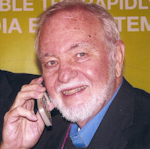A while back I wrote about some not-so-common wireless technologies that I called weird. Well, here is another few that you rarely if ever hear about. And just so you know, I define weird as new, interesting, and out of the ordinary. Not good, not bad…just different.
Li-Fi
Li-Fi, or Light Fidelity, is a visible light communications (VLC) technology. It uses light from LEDs as a carrier for high-speed data. The LEDs also serve to illuminate a room or an area in a building. Using amplitude modulation (AM), the light is turned off and on by the pulse train of data. Since light is everywhere in the room or area, it can be received by sensitive photodetectors. The rate is very high so the eye does not experience any flicker.
Using light as a carrier is certainly not new. Infrared (IR) invisible light has been used in fiber optic cables since their inception. And free space optical (FSO) equipment using IR is used as backhaul or wireless links in some urban networks. But visible light is different.
Two major benefits of Li-FI are the wide bandwidth available and non-line of sight (NLOS) operation. Wide bandwidth translates into high data rates. With just simple AM or on-off keying (OOK) modulation, data rates up to the 1 to 10 Gb/s range have been achieved. Second, NLOS operation is possible as Li-Fi also works with reflected light from walls or other objects.
The main limitation seems to be its downlink-only format. But there is provision for an uplink by way of an IR link. Wi-Fi or other wireless link would also work. Li-FI uses the standard Wi-Fi 802.11 protocol but other standards work is being done by the IEEE 802.15.7 group. The IEEE 802.15.7 standard defines VLC for both indoor and outdoor applications. It has potential for use in vehicle-to-vehicle (V2V) and vehicle-to-infrastructure (V2I) use cases.
LF and MF Ham Bands
Most amateur radio operations take place in the HF spectrum from 3 to 30 MHz and in the VHF and UHF bands. The FCC has adopted new rules that will soon permit operations in the low frequency (LF) and medium frequency (MF) bands. Specifically, the FCC says that hams will be allowed to use the 2,200-meter band from 135.7 kHz to 137.8 kHz, as well as the 630-meter band from 472 kHz to 479 kHz. The maximum effective isotropic radiated power (EIRP) is 5 watts in the 630 meter band and 1 watt in the 2200 meter band. Hams may use any mode, including CW, RTTY, voice, data, or video. With such narrow bandwidths available, I suspect CW or data will be the most common.
A major issue with operating at these low frequencies is antenna length. For other ham bands, a half-wavelength dipole or quarter-wave vertical are common. A half wave at 479 kHz is 977 feet. And at 137 kHz that half wavelength is 3416 feet or about two thirds of a mile. Impractical, to say the least. Most hams will probably use shorter wires with loading coils. Transmission range is limited by ground wave propagation, which is dominant at these low frequencies. It will certainly be enlightening to see how this develops. Equipment will certainly be cheap and simple and not critical. Home brew rigs will be common.
Submarine Radio
Speaking of low frequency, the new ham frequencies are not low at all. Submarines have used even lower frequencies—extremely low frequencies (ELF) in the 30 to 300 Hz range. The reason for this is that radio waves do not propagate well through salt water. Very low frequencies (VLF) in the 3 kHz to 30 kHz range can penetrate to a depth up to about 60 ft—not good enough for government work, as they say. But ELF waves can go down hundreds of feet. As a result, the Navy adopted 76 Hz as its operating frequency and built huge antenna farms and transmitters in Michigan and Wisconsin to communicate worldwide with submarines. Communications is obviously one way of using an encoded and encrypted data stream. Data rates are as low as 1 bps but sufficient for simple information. Using hundreds of megawatts of power, worldwide communications with submerged submarines is possible. This system is no longer in operation, and I almost didn’t include it. Nevertheless it is interesting.
All Digital Radio
Cambridge Consultants a UK research firm and inventor of the first Bluetooth radio IC, announced recently an all digital transmitter called Pizzicato that uses no analog circuitry. Quoting from its own news release, Cambridge says:
“The Pizzicato digital radio transmitter consists of an integrated circuit outputting a single stream of bits, and an antenna—with no conventional radio parts or digital-to-analog (DAC) converter. Patented algorithms perform the necessary ultra-fast computations in real time, making it possible for standard digital technology to directly generate high-frequency radio signals.”
It’s difficult to imagine what this is, exactly. When I think of digital radio I think of software-defined radios (SDR) with its I/Q architecture with DACs and ADCs using both analog and digital methods. But can you connect a digital stream directly to an antenna and make it work? There is obviously more to it than that. Other digital radios I think of when I ponder this one is impulse UWB, where there is no carrier—just short wavelets in a PSK format. Maybe the Cambridge radio is some kind of PWM or waveform synthesis scheme. Does it include a switching PA (class E, F, S)? It is hard to think of radio without analog, filters, and the like.
Anyway, we’d all love to know more. Cambridge, if you are listening, update us on this project. Let us hear about those patents and algorithms. If it will revolutionize 5G and IoT and solve the spectrum problem, we want to know.
As for you readers, let me know if you hear of any other weird wireless technologies.


